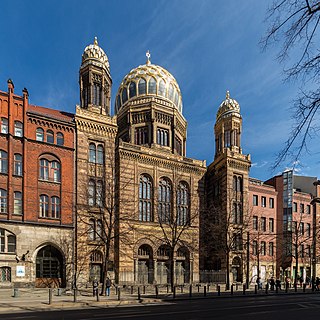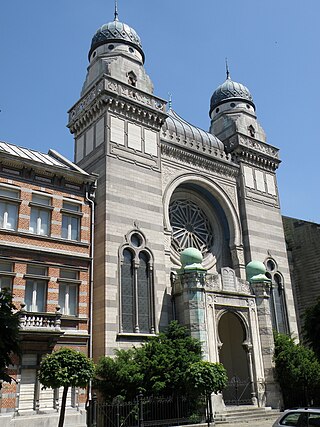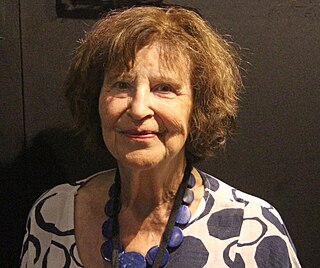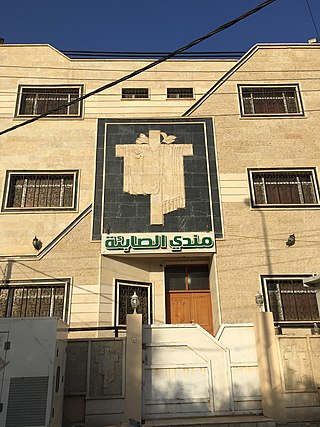



The Great Synagogue of Deventer (Dutch : Grote Synagoge van Deventer) is a synagogue in Deventer, Overijssel, Netherlands. [1]




The Great Synagogue of Deventer (Dutch : Grote Synagoge van Deventer) is a synagogue in Deventer, Overijssel, Netherlands. [1]
This temple was built in 1892 by J.A. Mulock Houwer. It is a Neo-Renaissance building with Moorish influences. [1] The structure includes minaret-like turrets, with crescents on either side. On the summit, just above the stone tablets with the Ten Commandments directly, was a large copper Star of David. The oriental style is a reference to the Taifa of Toledo, where, before 1492, peaceful and prosperous coexistence of Judaism with Islam and Christianity prevailed. The combination of crescents and a Star of David explicitly refers to the peaceful co-existence with Islam in Toledo.
During World War II, the interior was destroyed by Dutch Nazis (members of the Dutch Nazi-party NSB).
Between 1951 and 2010 it was used as a place of worship by the Christian Reformed Church in the Netherlands.
From 2010 to 2018 the building in use as a synagogue by the Jewish community Beth Shoshanna. [1]
In February 2018 the Christian Reformed Church in the Netherlands sold the building, while rented out Congregation Beth Shoshanna, to Lenferink Groep Zwolle, the real estate firm of investors Carlus Lenferink and Geert-Harm van der Maat. [2] A restaurant entrepreneur working with the firm, Ayhan Sahin, circulated plans to change the synagogue into a food hall. [2] [3] These food hall plans were met with strong objections. [4] [5] [6]

Deventer is a city and municipality in the Salland historical region of the province of Overijssel, Netherlands. In 2020 the municipality of Deventer had a population of 100,913. The city is largely situated on the east bank of the river IJssel, but it also has a small part of its territory on the west bank. In 2005 the municipality of Bathmen was merged with Deventer as part of a national effort to reduce bureaucracy in the country .

Goor is a city in the Dutch province of Overijssel. It is located about 20 kilometres (12 mi) west of Enschede. Goor received city rights in 1263.

The New Synagogue on Oranienburger Straße in Berlin is a mid-19th century synagogue built as the main place of worship for the city's Jewish community, succeeding the Old Synagogue which the community outgrew. Because of its eastern Moorish style and resemblance to the Alhambra, the New Synagogue is an important architectural monument in Germany.

The history of the Jews in the Netherlands largely dates to the late 16th century and 17th century, when Sephardic Jews from Portugal and Spain began to settle in Amsterdam and a few other Dutch cities, because the Netherlands was an unusual center of religious tolerance. Since Portuguese Jews had not lived under rabbinic authority for decades, the first generation of those embracing their ancestral religion had to be formally instructed in Jewish belief and practice. This contrasts with Ashkenazi Jews from central Europe, who, although persecuted, lived in organized communities. Seventeenth-century Amsterdam was referred to as the "Dutch Jerusalem" for its importance as a center of Jewish life. In the mid 17th century, Ashkenazi Jews from central and eastern Europe migrated. Both groups migrated for reasons of religious liberty, to escape persecution, now able to live openly as Jews in separate organized, autonomous Jewish communities under rabbinic authority. They were also drawn by the economic opportunities in the Netherlands, a major hub in world trade.
The Nederlands-Israëlitisch Kerkgenootschap (NIK) is the umbrella organisation for most Ashkenazi Jewish communities in the Netherlands, and is Orthodox in nature, while to be described as traditional in outlook. The expression Orthodox, is for the Dutch situation at least, of a later date than the existence of the congregations that make up the NIK and the NIK itself. The Rabbi of the NIK is Rabbi Dr. Raphael Evers. In total, the NIK has some 20 rabbis actively working in 18 congregations throughout the country, serving some 5,000 Jews.

The Nederlands Verbond voor Progressief Jodendom is the umbrella organisation for Progressive Jews in the Netherlands, and is affiliated to the World Union for Progressive Judaism. It was founded in 1931.

The Portuguese Synagogue, also known as the Esnoga, or Snoge, is a late 17th-century Sephardic synagogue in Amsterdam, completed in 1675. Esnoga is the word for synagogue in Judaeo-Spanish, the traditional Judaeo-Spanish language of Sephardi Jews.

The Synagogue Shomré Hadas, commonly known as the Hollandse Synagoge. is a Modern Orthodox synagogue built in Antwerp, Belgium. The building is so named because it was commissioned by descendants of Jews who came to Antwerp from the Netherlands in the early 19th century. It was the first large synagogue in Antwerp. Today the synagogue is used for services only on Rosh Hashana, Yom Kippur and Shabbat morning service.

Oude Pekela is a town in the Dutch province of Groningen. It is located in the municipality of Pekela, about 5 km southwest of Winschoten. It was established to exploit the peat in the area. During the 19th century, it was known for its maritime transport. During the 20th century, Oude Pekela became the centre of the cardboard and potato starch industry.
Samuel Pallache was a Jewish Moroccan merchant, diplomat, and pirate of the Pallache family, who, as envoy, concluded a treaty with the Dutch Republic in 1608. His antecedents fled to Morocco during the Reconquista. Appointed as an agent under the Saadi Sultan Zidan Abu Maali, Pallache traveled to the newly-independent Dutch Republic to discuss diplomatic terms with the Dutch against their mutual enemy, the Spanish. He died in the Netherlands, brought there due to the intervention of his ally, Maurice of Nassau, who helped him when he was arrested by the Spanish.

The History of the Jews in Amsterdam focuses on the historical center of the Dutch Jewish community, comprising both Portuguese Jews originally from both Spain and Portugal and Ashkenazi Jews, originally from central Europe. The two separate groups have had a continuing presence since the seventeenth century. Amsterdam has been called a Jerusalem of the West and the "Dutch Jerusalem". The Holocaust in the Netherlands devastated the Jewish community, with the Nazis murdering some 75% of the approximately 80,000 Jews at time present in Amsterdam, but the community has managed to rebuild a vibrant and living Jewish life for its approximately 15,000 present members.

Jan de Beijer, also given as Jan de Beyer, was a Dutch draughtsman and painter known for this drawings of towns and buildings in the present-day countries of the Netherlands, Belgium and Germany. In total, he produced some 1500 drawings, over 600 of which were reproduced as engravings by other artists.
The Jodenbuurt is a neighbourhood of Amsterdam, Netherlands. For centuries before World War II, it was the center of the Dutch Jews of Amsterdam — hence, its name. It is best known as the birthplace of Baruch Spinoza, the home of Rembrandt, and the Jewish ghetto of Nazi occupation of the Netherlands.

Johan Willem van Hulst was a Dutch school director, university professor, author, politician, chess player and centenarian. In 1943, with the help of the Dutch resistance and students of the nearby University of Amsterdam, he was instrumental in saving over 600 Jewish children from the nursery of the Hollandsche Schouwburg who were destined for deportation to Nazi concentration camps. For his humanitarian actions he received the Yad Vashem distinction Righteous Among the Nations from the State of Israel in 1973.

Saskia Weishut-Snapper is a Dutch fiber artist.

The Surabaya Synagogue was a former synagogue in Surabaya, Indonesia. It is generally said to have been the only synagogue in the country during the years it operated, although since then Sha'ar Hashamayim has opened in Sulawesi. The Surabaya Synagogue building was a former private residence purchased by the Israelitische Gemeente Soerabaia congregation in 1948. Unfortunately, due to world events and Indonesian politics, most of the congregation emigrated in the decade after it opened. The building continued to be used by a tiny community and fell into disrepair by the late twentieth century; it was controversially demolished in 2013 despite receiving some recognition as a heritage building.
Max Reisel was a Dutch semiticist and a teacher at the Montessori Lyceum Rotterdam. He strove in the dissemination of knowledge about Judaism in general and Hebrew language in particular. He played an important role in the field of education in the Netherlands.

A mandi, mashkhanna, or beth manda, is a Mandaean building that serves as a community center and place of worship. A mandi is traditionally built on the banks of a yardna, or flowing river.

The Jewish cemetery in Hoorn can refer to the original Jewish cemetery on the outskirts of the Dutch city of Hoorn, or to a separate section of today's public cemetery. That Jewish section was opened in 1968, after the old Jewish cemetery was cleared for road construction.